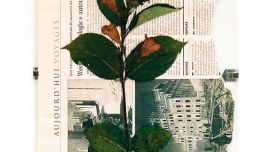What interactions are we made of? What is our relationship to the beings, places and things that surround us? How does remembering past events and recorded images link us to ourselves and to others?
Here is my design: questioning and updating one’s memories, comparing them with objects one mysteriously kept along one’s path, with photographical or digital tracks and trying to understand their relationship to one another. The archeologist investigates the ruins of a time that has past and is gone in order to better apprehend a civilization, an era or a human group. I try to grasp remains of personal events and to figure their genealogy out. There are crossroads, separations, parallelisms, superpositions and successions in the paths followed by people, things and facts. Many are the perspectives that confuse my perception.
Each step of this investigation announces or anticipates the next. The means of representation I used are like a metaphor of the processes at stake. There is a feeling of vertigo that comes from the abyss-like gap between the images and those they are calling on to.
I used the following media: photographs, pictorial or textile representation of photographs, video, drawings, digital manipulations, scale changes, simplification, repetition, addition of natural elements, of objects and of pieces of work produced by Alix or by myself, association by montage or by spatial reunion.
The idea is to create discontinuity in continuity, or unity in fragmentation, in the same way that digital images can appear to be either smooth or disrupted depending on how they were manipulated – enlargement, compression, filters, montages and so on.
Hidden links are revealed by the analyzing of documents, by the confronting of them and by the play of interactions thus created. Bridges are built from one event to an other. Just as fabric gets creased, time and space are brought together or pulled apart. The line drawn between imagination and memory is blurred. Personal History and communal History answer one another.
Throughout the process, elements appear that call for attention. In this case for instance, even though the project is originally a study of eight photographical documents and a sheet embroidered with initials, it is the bathing suit worn by the photographed child that focalizes the onlooker’s interest.
This piece of clothing that was given to Alix in June 2000 is like the witness of a private story and thus bears a strong affective quality. However, more than its own existence, the american bathing suit carries within itself the relationships and the facts that led it to be part of Alix’s life. Whether they are physical or cultural, social or political, signs of a different time will thus be shown through images.
This project of the american bathing suit has been influenced by contemporary artists (Giuseppe Penone, Sophie Calle) as well as literary works (Jean Geant, Paul Celan, W.G. Sebald) and scientific essays (Leroy-Gourhand, Papadopoulo-Belmehdi).









![Vue de l'exposition [Le maillot de bain américain], Milizac, février 2011](https://www.marieclaireraoul.fr/mcr-portfolio/wp-content/uploads/2014/02/exposition-millizac-2011-2799-marie-claire-raoul-269x152.jpg)